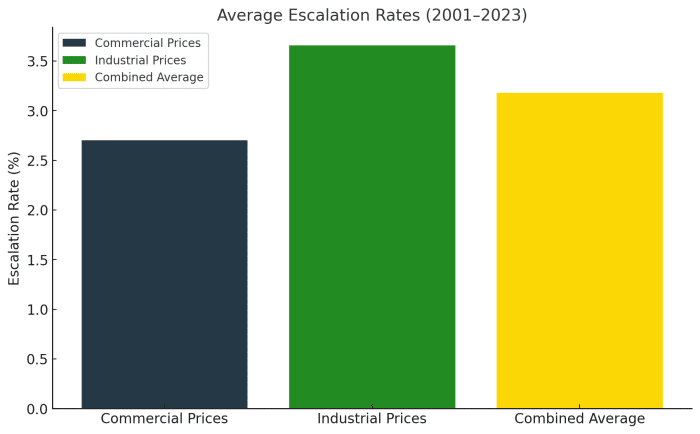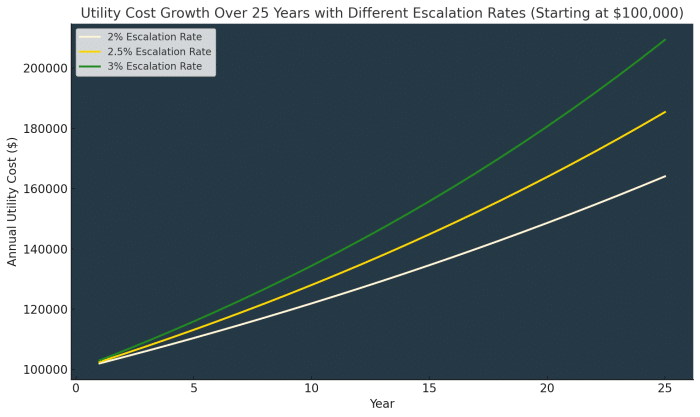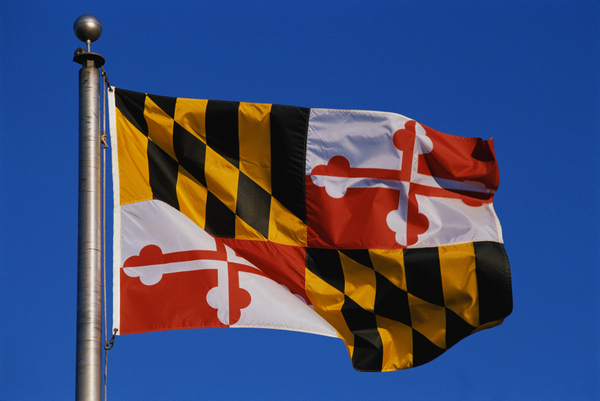Utility rate escalation is trending up according to new study

The annualized utility rate escalation input is one of the most influential factors in a financial model when determining the lifetime economics of a solar project. Commercial real estate and solar professionals have traditionally used a 2% utility rate escalation in their proformas, assuming a steady increase in energy costs over time.
However, a deeper look at U.S. Energy Information Administration (EIA) data from SolarKal reveals that this assumption may no longer hold true. The findings show that utility rates, especially in certain regions, have been escalating at a much faster pace.
Utility rate escalation study findings
Analysis of retail commercial and industrial electricity price data from 2001 to 2023 concludes that the average escalation rate is closer to 2.5% for top solar states, with variation by state. For example, California—a key outlier—has seen rates climb higher, sometimes exceeding 3% annually.
Top states saw an escalation rate closer to 2.7% for commercial prices and 3.7% for industrial prices, indicating that even a 2.5% escalation rate could be considered conservative. It is worth noting that these escalation rates include outlier years (years that saw dramatic price fluctuations). When excluding outlier years, the escalation rates fall more in line with the standard 2% rate.
However, factors like regulatory changes, extreme weather, and geopolitical tensions suggest that these fluctuations are not anomalies but represent a new norm in the energy landscape. Reports indicate that these fluctuations are becoming more frequent and are “here to stay” (S&P Global), suggesting that businesses should consider them as part of long-term energy planning.
Utility data by sector

These figures were derived from historical data provided by the EIA, and additional projections were made using Excel’s FORECAST.ETS function to estimate future pricing trends through 2029.
Regional outliers: Certain states, such as California, have seen consistent rate hikes exceeding 3% annually, making them notable outliers. Other regions, like Washington, D.C., as well as Rhode Island and Maryland, have also experienced faster-than-expected utility cost increases. With the winter season approaching, further rate hikes are expected, making it essential to stay prepared with accurate forecasts.
Impact of a minor escalation rate change
Consider a commercial real estate project with an annual utility cost of $100,000. If we assume a 25-year project time frame, here’s how the total utility cost could grow with different escalation rates:

2% Escalation Rate: In this scenario, the utility cost grows by the standard 2% annually. Over 25 years, the compounded cost will be significantly higher than the initial $100,000 per year. By year 25, the annual utility cost would be approximately $164,000. The total cost over the entire 25-year period would be around $3.37 million.
2.5% Escalation Rate: With just a half-percentage-point increase to 2.5%, the annual utility cost would grow faster. By year 25, the annual utility cost would reach around $185,000. The total cost over the 25-year period would be approximately $3.60 million.
In this simple example, the difference between a 2% and 2.5% escalation rate results in nearly $250,000 in additional utility costs over 25 years. Furthermore, a state with an escalation rate closer to 3% would see an approximate $500,000 in additional utility costs over 25 years compared with a 2% escalation rate.
While half a percentage point may seem minor in the short term, it can result in significant cost differences over the life of a project.
Implications for C&I solar
Installing solar energy systems provides buildings in the C&I sector with a predictable, long-term energy solution that can reduce or even eliminate reliance on the grid. This enables companies to stabilize their energy costs by locking in lower rates for 20 to 25 years — the typical lifespan of a solar system.
By switching to solar, companies can mitigate the effects of rising utility prices. With grid electricity costs rising at rates of 2.5% or higher, generating your own power is a proactive move to safeguard against unpredictable price hikes and enhance long-term financial resilience.
Escalating utility rates are a pressing challenge that real estate professionals can’t afford to ignore. Based on these findings, we recommend that real estate owners and managers reassess the escalation rates in their models, adjusting for regional variations and industry-specific risks. While changing the assumed rate from 2% to closer to 2.5% (or even higher in certain regions) may seem like a minor tweak, it can have a profound effect on long-term financial planning.
Joseph Rizzotti is an associate with SolarKal, a solar advisory firm that works closely with more than 50 commercial real estate companies, publicly traded REITs, Fortune 500 companies, national education organizations, and commercial properties from the East Coast to the West. Learn more at: SolarKal.com





Comments are closed here.